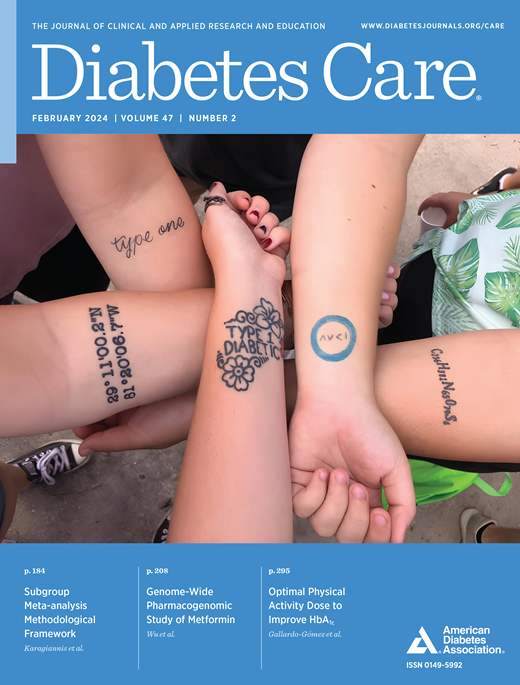在常规临床护理中使用 SGLT2i 与 GLP-1RA 的 2 型糖尿病患者发生尿路感染的风险:一项丹麦队列研究
IF 16.6
1区 医学
Q1 ENDOCRINOLOGY & METABOLISM
引用次数: 0
摘要
目的与钠-葡萄糖共转运蛋白2抑制剂(SGLT2i)相关的尿路感染(UTI)和生殖道感染(GTI)的预期风险可能会阻止其在临床应用。我们研究了与胰高血糖素样肽1受体激动剂(GLP-1RAs)相比,启动SGLT2i是否与2型糖尿病患者UTI和GTI风险升高有关。研究设计和方法在这项模拟目标试验的队列研究中,我们纳入了2016-2021年在丹麦启动SGLT2i或GLP-1RAs的所有成年二甲双胍使用者,并使用反概率治疗(IPT)加权来平衡潜在的混杂因素。我们估计了社区或医院治疗的UTI和GTI的ipt加权风险和风险比,进行了意向治疗和治疗分析。该研究纳入了52414例SGLT2i启动者和27023例GLP-1RA启动者,中位随访时间为2.9 - 3.9年。在意向治疗分析中,第一年尿路感染的估计风险几乎相同:SGLT2i患者为10.0%,GLP-1RAs患者为10.2%,风险比为0.98 (95% CI 0.94, 1.03)。对于GTI, SGLT2i治疗下的1年风险升高,分别为2.0%和0.7%(风险比2.95 [95% CI 2.52, 3.44])。在5年随访期间,相对UTI风险几乎保持不变(0.96 [95% CI 0.94, 0.99]),而SGLT2is的GTI风险比降至1.64 (95% CI 1.49, 1.80)。结论:在常规临床护理中,与GLP-1RA起始相比,SGLT2i起始与UTI风险增加无关。然而,SGLT2i患者的早期GTI风险高达三倍。本文章由计算机程序翻译,如有差异,请以英文原文为准。
Risk of Urogenital Infections in People With Type 2 Diabetes Initiating SGLT2i Versus GLP-1RA in Routine Clinical Care: A Danish Cohort Study
OBJECTIVE Anticipated risks of urinary tract infections (UTI) and genital tract infections (GTI) associated with sodium–glucose cotransporter 2 inhibitors (SGLT2i) may prevent their use in clinical practice. We investigated whether initiation of SGLT2i, compared with glucagon-like peptide 1 receptor agonists (GLP-1RAs), was associated with an elevated risk of UTI and GTI in people with type 2 diabetes. RESEARCH DESIGN AND METHODS In this cohort study emulating a target trial, we included all adult metformin users initiating SGLT2i or GLP-1RAs in Denmark in 2016–2021 and used inverse-probability of treatment (IPT) weighting to balance potential confounders. We estimated IPT-weighted risk and risk ratios of community- or hospital-treated UTI and GTI, performing both intention-to-treat and on-treatment analyses. RESULTS This study included 52,414 SGLT2i initiators and 27,023 GLP-1RA initiators with a median follow-up of 2.9 to 3.9 years. The estimated risks of UTI within the first year were nearly identical: 10.0% in SGLT2i and 10.2% in GLP-1RAs in intention-to-treat analyses corresponding to a risk ratio of 0.98 (95% CI 0.94, 1.03). For GTI, the 1-year risks were elevated under SGLT2i therapy at 2.0% vs. 0.7% (risk ratio 2.95 [95% CI 2.52, 3.44]). During the 5-year follow-up, the relative UTI risk remained almost constant (0.96 [95% CI 0.94, 0.99]) whereas the GTI risk ratio with SGLT2is decreased to 1.64 (95% CI 1.49, 1.80). CONCLUSIONS In routine clinical care, SGLT2i initiation is not associated with increased risk of UTI compared with GLP-1RA initiation. However, early GTI risk is up to threefold larger in SGLT2i users.
求助全文
通过发布文献求助,成功后即可免费获取论文全文。
去求助
来源期刊

Diabetes Care
医学-内分泌学与代谢
CiteScore
27.80
自引率
4.90%
发文量
449
审稿时长
1 months
期刊介绍:
The journal's overarching mission can be captured by the simple word "Care," reflecting its commitment to enhancing patient well-being. Diabetes Care aims to support better patient care by addressing the comprehensive needs of healthcare professionals dedicated to managing diabetes.
Diabetes Care serves as a valuable resource for healthcare practitioners, aiming to advance knowledge, foster research, and improve diabetes management. The journal publishes original research across various categories, including Clinical Care, Education, Nutrition, Psychosocial Research, Epidemiology, Health Services Research, Emerging Treatments and Technologies, Pathophysiology, Complications, and Cardiovascular and Metabolic Risk. Additionally, Diabetes Care features ADA statements, consensus reports, review articles, letters to the editor, and health/medical news, appealing to a diverse audience of physicians, researchers, psychologists, educators, and other healthcare professionals.
 求助内容:
求助内容: 应助结果提醒方式:
应助结果提醒方式:


